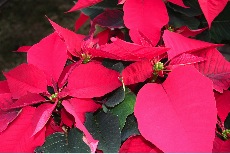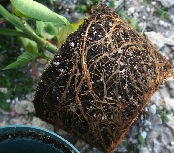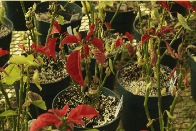Download Caring for poinsettia PDF (PLPA-108)
 Did you know that the Poinsettia is a native plant of Mexico? The Aztecs used to cultivate these plants for their brilliant colors. During the Christmas season, we see lots of poinsettias in the lab. Here are some tips to care for your poinsettia to keep them looking good and to avoid some of the common diseases that affect them.
Did you know that the Poinsettia is a native plant of Mexico? The Aztecs used to cultivate these plants for their brilliant colors. During the Christmas season, we see lots of poinsettias in the lab. Here are some tips to care for your poinsettia to keep them looking good and to avoid some of the common diseases that affect them.

COMMON DISEASES:
Pythium root rot is a common pathogen of Poinsettias. The pathogen attacks the roots of the poinsettia, causing them to change from a clean white to brown and mushy. When the poinsettias are sold, they are typically placed in a protective sleeve to prevent damage during shipping. These sleeves do not have drainage holes in the bottom. When water is allowed to stand in this sleeve, it encourages root rot from this pathogen. As the roots are destroyed, the plant will begin yellowing and dropping leaves. So remove the sleeves as soon as you get home!
 There are also several diseases that show up as spots or blotches on the leaves of poinsettias, typically on the lower (green) leaves. Many times, these are due to improper watering and stressing the plant. Removing the leaves and properly caring for your poinsettia will usually reduce the disease. However, prevention is always better than cure.
There are also several diseases that show up as spots or blotches on the leaves of poinsettias, typically on the lower (green) leaves. Many times, these are due to improper watering and stressing the plant. Removing the leaves and properly caring for your poinsettia will usually reduce the disease. However, prevention is always better than cure.
Here are some tips for reducing environmental stress on your poinsettia:
- Do NOT expose to cold or hot drafts. Poinsettias does best at 60-70 °F. If these plants get too cold, they can turn yellow and drop leaves rapidly.
- Do NOT drown poinsettia. Water only when the soil feels dry to the touch. Overwatering will encourage diseases.
- Do NOT fertilize when in bloom. This will help to maintain the bright colors through the Christmas season. DO fertilize after the season if you wish to keep the plant growing.
For more information on the history and diseases of poinsettias, check out this feature from the American Phytopathological Society at http://www.apsnet.org/online/feature/xmasflower/